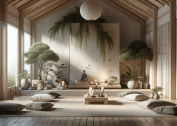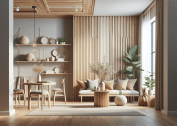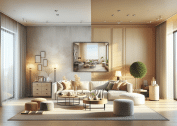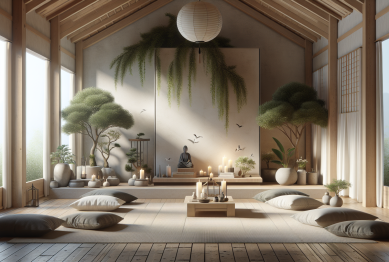Unlock creative ideas for turning tiny living areas into calming retreats. Explore tips, style guides, design secrets, and wellness concepts that help you maximize comfort, style, and relaxation—no matter the room’s size.
Discovering Comfort in Limited Living Areas
Living in compact spaces is increasingly common. Whether it’s a city apartment or a cozy studio, many people seek creative solutions for wellness and relaxation where square footage is limited. Designing a calming retreat starts with understanding the potential of every corner. Clever organization, mindful furniture choices, and an intentional color palette can all work wonders. Creating a sense of serenity does not always require expansive rooms. Instead, comfort is often found through smart arrangement and creative use of light and textures. Exploring ways to bring tranquility to small spaces often leads to memorable results and improved day-to-day living.
Choosing multi-purpose furniture plays a crucial role in maximizing both utility and relaxation. Fold-out beds, stackable chairs, ottomans with storage, and nesting tables help create flexibility. Individuals who invest in convertible or modular items often report greater control over their environment. The ability to change layouts or stow furniture when not needed keeps spaces airy and functional. Research from interior design experts suggests that decluttering and proper zoning can create a psychological sense of openness, reducing stress even in diminutive rooms (https://www.houzz.com/magazine/7-ways-to-make-small-spaces-feel-bigger-stsetivw-vs~27253864).
Colors and soft lighting also play vital roles. Muted pastels, light grays, and creamy whites can open up a room visually, while warm LED lights provide a cozy ambiance. Incorporating personal touches—like art or handmade décor—infuses charm without occupying precious space. Plants, too, can transform energy, promoting a calming living environment. Research from horticultural journals suggests that greenery in indoor spaces can help regulate stress levels and boost mood naturally (https://www.ncbi.nlm.nih.gov/pmc/articles/PMC4419447/).
Smart Storage Solutions for Style and Order
Storage can make or break the atmosphere in a small room. Invisible chaos—items tucked away in random spots—creates anxiety and disrupts relaxation. Built-in shelving, under-bed drawers, vertical racks, and wall hooks are style-forward ways to optimize square footage. Many design experts recommend using baskets and labeled bins to corral clutter stylishly (https://www.architecturaldigest.com/story/storage-solutions-for-small-spaces). Open shelving can display books or cherished keepsakes, while closed cabinets keep necessities hidden but accessible. The trick lies in striking a balance between function and form.
Keeping surfaces clear is important for mental wellness in tight quarters. Even a coffee table can serve double duty: trays organize remotes or books, while vintage trunks offer both charm and storage. Furniture that hides everyday essentials prevents visual overload, and those who commit to regular tidying often find that their living spaces feel more luxurious despite modest dimensions.
Smart storage also embraces technology. Ultra-slim charging stations cut cord clutter, and wall-mounted organizers keep paperwork in check. Magnetic racks for spices, hanging shoe caddies, and sleek bathroom shelves let every object shine without crowding counters or floors. Creating zones—such as a quiet reading nook with a tidy basket for throws—helps maintain a sense of order and harmony.
Design Secrets for Enhancing Peace and Relaxation
Colors, scents, sounds—all have profound impacts on mood. In small living areas, intentional design choices elevate everyday comfort. Placing mirrors to reflect natural light creates the illusion of more space, instantly lifting the room’s energy. Designers also recommend layering textures—cotton throws, plush rugs, soft velvet cushions—to provide the senses with restful variety. Studies suggest tactile contrast can encourage relaxation and signal ‘sanctuary’ even in busy homes (https://www.verywellmind.com/how-to-create-a-relaxing-home-5095280).
Aromatherapy is a simple yet powerful way to transform atmosphere. Essential oil diffusers or scented candles—with calming notes like lavender or sandalwood—can transition small living spaces from work-at-home stress to after-hours tranquility. Sound, too, plays a surprising role; the soft trickle of a desktop fountain or nature-inspired playlists can mask city noise and cultivate peace. Together, these elements help shape a home retreat distinctly your own.
Visual clutter is minimized by editing down, not out: group decorative objects in sets of odd numbers, display only favorite art, and keep window treatments light and airy. This intentional styling helps your living area feel like a true escape. Introducing flexible lighting, such as dimmable lamps or fairy lights, sets the mood for any occasion, from morning meditation to evening reading. These design secrets work together to make small space living both comforting and inspiring.
Incorporating Wellness Practices at Home
Wellness and interior design increasingly overlap. It’s possible to build habits and routines right in the heart of your home, no special equipment required. Carving out a meditation corner or yoga nook—even if it’s just a cushion and plant—can work wonders for daily stress management. Researchers have found that a defined wellness or hobby spot positively influences mindfulness and supports emotional balance (https://www.ncbi.nlm.nih.gov/pmc/articles/PMC6222349/).
Lighting is vital for mood and physical health. Natural sunlight, even from a single window, improves serotonin levels and sleep quality. When outdoor light is limited, full-spectrum lamps make a worthy substitute for maintaining energy levels indoors. Many individuals schedule mindful breaks throughout the day—to stretch, breathe, or simply pause—which can be seamlessly integrated into small-space living routines.
Tech-free zones are trending. Placing a tray for devices at the entryway or creating hours when screens are off encourages relaxation and deeper connection. Reading, listening to music, journaling, or easy indoor gardening can all serve as restorative rituals. Prioritizing well-being in your home helps maintain calm, even as life outside feels busy. Exploring such habits often leads to sustainable lifestyle improvements over time.
Personalizing Your Retreat: Art, Culture, and Connection
Personal expression is at the heart of enjoyable home design. Small spaces are perfect canvases for creativity. Displaying favorite artwork, family photos, or unique souvenirs infuses your retreat with meaning. Experts say surrounding yourself with positive reminders or inspiring items fosters ongoing uplift—each glance celebrates who you are (https://www.psychologytoday.com/us/blog/the-artful-mind/201802/how-our-home-affects-our-mental-health).
Culture shapes how individuals style their spaces. Incorporating traditional crafts, textiles, or music creates a comforting sense of identity and connection. Many individuals blend new trends with classic elements, resulting in a space that’s both contemporary and deeply rooted in personal history. This approach enhances belonging and emotional contentment, making even the smallest home feel significant.
Finally, inviting others into your retreat—whether for virtual catch-ups or intimate dinners—strengthens the sense of welcome. Thoughtful design doesn’t just support solo relaxation; it provides a foundation for meaningful connections. In the end, every detail you choose—from reading chairs to playlists—can reflect care, joy, and hospitality for everyone who visits or lives there.
Easy Upgrades for Ongoing Inspiration
Refreshing your small space does not require a full makeover. Simple updates—rotating art, adding seasonal plants, or swapping out accent pillows—can quickly rejuvenate energy. Rearranging furniture can also reveal hidden potential. Many design enthusiasts recommend testing new layouts every few months for a fresh perspective and renewed creativity (https://www.housebeautiful.com/room-decorating/small-spaces/a1939/10-small-space-decorating-tips/).
Small investments often yield big mood boosts. A new lamp or art print, fresh bedding, or a DIY wall mural are all affordable ways to keep your space feeling interesting and alive. Maybe switch scents or experiment with kitchen herbs on the windowsill. The key is to allow your retreat to evolve alongside your needs and preferences, supporting both relaxation and functionality.
Even with constraints, designing a personal sanctuary is within reach. Stay open to inspiration: scan design websites, watch virtual tours, and borrow ideas from friends. Your unique vision—combined with creativity and intention—will continually transform your space into a true haven. Enjoy the journey, knowing that comfort and beauty are always possible, even in the coziest retreats.
References
1. Houzz. (n.d.). 7 Ways to Make Small Spaces Feel Bigger. Retrieved from https://www.houzz.com/magazine/7-ways-to-make-small-spaces-feel-bigger-stsetivw-vs~27253864
2. Park, S.-H., & Mattson, R. H. (2017). Effects of Plants in Humidifying, Stress Relief, and Indoor Air Quality. Journal of Physiological Anthropology. Retrieved from https://www.ncbi.nlm.nih.gov/pmc/articles/PMC4419447/
3. Architectural Digest. (n.d.). 16 Storage Ideas for Small Spaces. Retrieved from https://www.architecturaldigest.com/story/storage-solutions-for-small-spaces
4. Verywell Mind. (n.d.). How to Create a Relaxing Home. Retrieved from https://www.verywellmind.com/how-to-create-a-relaxing-home-5095280
5. Frontiers in Psychology. (2018). Mindfulness and Well-Being: Living with Mindful Awareness. Retrieved from https://www.ncbi.nlm.nih.gov/pmc/articles/PMC6222349/
6. Psychology Today. (2018). How Our Home Affects Our Mental Health. Retrieved from https://www.psychologytoday.com/us/blog/the-artful-mind/201802/how-our-home-affects-our-mental-health









